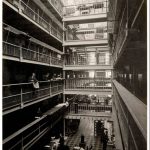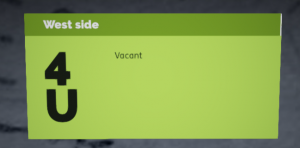The hundredth anniversary of our destruction of the Record Treasury of the Public Record Office of Ireland fell a week ago and the dust has now settled on the launch of www.virtualtreasury.ie, our response to that catastrophe. For the past few years, the project was trailed (“beyond2022.ie”) as a reconstruction of the collections burnt in 1922. The PR-fueled headlines on Irish media were that “technology” (whatever that is) was going to restore everything lost a century ago: just don your immersive headset and swim off through the 1821 census, mar dhea. Anyone with a titter of wit (a group that apparently doesn’t include many Irish news editors) could see this was just smoke-blowing.


So now that it’s live, what’s the verdict? On the Virtual Reality side, the first thing to be said is that the reconstruction of the Treasury building is superb. To be able to wander through the magnificent galleries and empty spaces that held all those records is awe-inspiring and not a little sad. The second thing is that the “Treasury View”, a VR doll’s-house view of the locations of records inside the building before 1922, is just silly. This is the part of the site closest to that blown PR smoke. For anyone trying to access records it’s useless, an online exhibition maybe, certainly not a restoration or reconstruction.

The real meat is buried away in the emphatically non-VR Browse section. Not “Browse All”, which is a dutiful and impressive listing of partner institutions and their records, the other one, “Browse PROI Catalogue”. This makes it clear that the heart of the project is to take Herbert Wood’s massive 1919 published listing of PROI holdings (helpfully included at the bottom of the page) and use it as a vast series of pigeonholes for substitutes, copies and abstracts of those destroyed holdings. The sheer chutzpah required even to attempt this is just jaw-dropping. Hats off: there are several lifetimes’ work here.
This approach creates its own problems, though. The main one is the huge warren of sub-sub-categories inside sub-categories, a large majority of which ultimately lead to a bald “Destroyed”. The rabbit-holes vastly outnumber the rabbits. Another is that Wood’s record hierarchy is deeply unintuitive for researchers a century later. “Extinct Jurisdictions” gets a top-level listing, while the giant 19th-century census holdings are stuffed away down in sub-section 9 of “Miscellaneous documents”. The priorities of Edwardian gentlemen record-keepers are emphatically not ours.
Still, there are gems all over the place: Digital copies of the National Archives of Ireland’s Church of Ireland registers (some of them, at least); The best account I’ve read of the 1766 census, with surviving transcripts all in the one place; links to the details of individual tenants under the Land Acts; A transcript of the 1831 census for Inishtioge in Kilkenny; The minute book of the Corporation of Brewers and Maltsters of Dublin; Herbert Wood’s wonderful account of Certain Registers of Irregular Marriages Celebrated by Unlicensed Clergymen, Known as Couple-Beggars.
But trying to get at the gems can be excruciating. A little less software engineering and a little more focus on the research experience would help. By which I mean a simple, regularly-updated plain text listing of all the transcripts and images on the site. Please?
More at https://youtu.be/b-FAfkJBX-o
AMEN!! I followed rabbit holes for a while and found some enjoyable searchable entries for the schoolchildrens’ essays taken in the 1930’s. Very fun cultural glimpses! But not the veritable treasure-trove of genealogical gems as advertised. We knew it wasn’t going to be all it was cracked up to be, and that it will perhaps be much better years down the road – but you are right about the emphasis on flashy (still not particularly user-friendly) graphics. Years ago I campaigned for a project that would actually (gasp!) include users in the design phases of a big database project. We won some input but it was a big hill to laboriously climb. Apparently they didn’t ask John Grenham, Ireland’s keymaster to existing records, for input. THAT was quite a missed opportunity!
I’m glad to hear that I was not the only one not liking the roll-out. As the 3x grt grand daughter of William Ryan and Catherine Burke (abt 179 – ?, Tipperary), I am hoping to put a chink in the brick wall from all of this.
Yes, hats off, indeed!
To your final point about the research experience: Perhaps there’s a way of distributing the transcription workload. It would be great if a group of volunteers could be recruited to input text, index, and tag a wide range of details within this new collection toward the goal of improving research experiences on virtualtreasury.ie. I believe AmericanAncestors.org is one such site that benefits from this approach.
Some years ago, the ZOONIVERSE website involved people from across the world in digitising the war diaries of various WW1 regiments.
As I understand it, each diary was transcribed by different volunteers and their results compared before being published by the museum responsible (I think it was the Imperial War Museum).
Each volunteer could tag names appearing in the diaries, and this went on to form part of the digital index.
John, I’ve been checking it since 27 June and do find it more than a bit confusing! Glad to hear I’m not the only one. The Inquisitions Post Mortems are marvellous though my Latin is quite not up to speed. I’d be happier with something like the Cong or Ahascragh parish records yet I end up back where I started without reading them inbetween (really, any Galway CoI registers would be great, especially starting 17–. Had to stop for a few days as it was taking up way too much time figuring navigation. Don’t wish to be too critical as I really do appreciate the work that has gone into this, but am confused. Will just have to keep at it.
So grateful for your “Rabbit-holes” and as always, I just know you are spot on!!
John, Thar cionn … spriongai dochais siorai!
Thank you John. I thought I was a bit thick – well a lot thick as I was spinning in circles – did however work it out eventually – I think – great fun to wander around the reconstruction but tiny scraps for genealogists – big bites for historians – heartfelt effort but Herbert Wood’s book is still the saddest book in Ireland.
There are some records from the 1841 and 1851 censuses. when people applied for the O.A.P. from 1908 onwards they often used the above censuses as proof of age, so quite a number of records are preserved, but I’m not certain that any effort has been made to organize and catalog these records.
Agreed! I second your request for a better search facility – and the ability to download documents.
Hello, I recently asked for full access to the 1901 and 1911 Irish census and was told it was unlikely, and lets have a zoom call to discuss my idea for a project. The project I am proposing is that starting at the 1911 census, and by incorporating the Registration BMD it should be possible in my view to reconstruct a sizeable portion of the 1921 census, and when the 1926 census is eventually released to us a reconciled revision made. In a similar way and as an initial trial of methodology a 1901 census should be possible by the same principles, but this time the actual data is available to compare with, and an estimate of what was not possible to find. made. I understand maybe someone would correct me if I’m wrong, the overall analysis of all the census from 1821 to 1901 are still in existence, and have been used for the intended reasons of planning ahead, so would be able to form the basic level of data to be expected at each ten year interval. The next step would be to recreate the 1891 census, working back from the two previous data sets, where available the actual portions of the real census data that have survived should be incorporated, along with those records of pensions extracts, taxation and other records which have survived. I have now Emailed the senior person Dr Peter Crocks for his response to this idea, which I would have thought was an obvious feature of lost records to recreate!
I think this is a perfect example of why we can’t have nice things. God forbid someone should make an attempt at recovering some of the material from the period and putting it all in one place. Maybe we should ask them to take it down and then we can go back to grouching about how hard Irish genealogy is? Realistically we will never retrieve the majority of what was lost in 1922, especially material that is genealogically useful. Instead as we get more familiar with the database and more material is added, hopefully we will find useful bits of information.
David, while I admire your faith in the database, I doubt very much if there will be any additions in the near future unfortunately.
Many thanks John for doing the hard yards of analysing the Treasury and providing this very helpful blog post and video. You have saved me a lot of time. Please keep up the great work.
Having watched your video on this I tried to replicate your use of the site’s Browse to reach the PRO “Miscellaneous” , and see no such subheading under PRO. Neither did I find PROI ETC, the Eccclesiastical and Testamentary Collection. Has it been whisked away and if so, why ? or am I somehow missing a step in finding it ?
Hi Catherine
No, you’re not missing a step. The Virtual Treasury have changed the navigation hierarchy under https://virtualtreasury.ie/browse?directory=proi, leaving out much that was originally there. You can still get to (e.g.) PROI ETC by manipulating the URL. So virtualtreasury.ie/item?isadgReferenceCode=PROI ETC 1/1 takes you to the first sub-item in the first section of ETC. Changing 1/1 to 2/1 takes you the first sub-item in the second section of ETC and so on.
I have no idea why the changes were made. It’s no way to run a website.
John
Thank you very much. Thanks for the workaround. It seems impossible to understand why they would remove accessibility, but I am happy to hear these items still available, and I will enjoy looking -and trying out the name search feature tip in your video too. Catherine